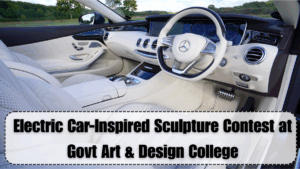In a bold and creative move, government art institutions in India have turned electric mobility into a muse. The EV-inspired sculpture competition hosted by leading Government Art & Design Colleges in 2025 has brought together artistic minds to rethink what sustainability looks like in form and structure. Blending futuristic themes with cultural expression, this year’s contest has become a symbol of innovation in both the automotive and art worlds.
From battery cells carved in stone to aerodynamic e-mobility silhouettes in recycled metal, student participants are showcasing how EV sculpture can spark fresh perspectives on clean energy and transportation.

What Makes the 2025 Contest Unique
Unlike traditional art shows, this EV-inspired sculpture competition focused entirely on themes inspired by electric cars, mobility evolution, and ecological values. Organized by institutes like the Delhi College of Art, Sir J.J. School of Art Mumbai, and Bengaluru Institute of Design, the contest had a clear goal—translate motion and sustainability into sculpture.
Key highlights included:
-
Sculptures using recycled car parts, wires, and rubber
-
Abstract pieces representing EV energy flow and AI integration
-
Installations combining sculpture with light and sound to mimic electric pulses
-
3D-printed student models of futuristic EV ecosystems
Every design contest entry had to be functional, conceptual, or symbolic—bridging the gap between art and industry.
Student Art Meets Clean Technology
The rising generation of artists is more tech-aware than ever. Through this student art contest, students were encouraged to explore the intersection of emotion, innovation, and sustainability:
-
How does an EV’s silence inspire sculpture?
-
What do battery packs represent in cultural context?
-
Can mobility be visualized in stillness?
Using these questions, participants crafted pieces that challenged both technical design and societal norms.
Notable Winners and Their Work
The top 3 winning sculptures have captured the imagination of art and automotive enthusiasts alike:
| Winner | Title | Concept |
|---|---|---|
| Ananya Verma – Delhi College of Art | “Pulse of the Wheel” | A kinetic sculpture showing motion without fuel |
| Raj Karan – JJ School of Art | “Charging Roots” | EV battery cells shaped into a tree, representing energy rebirth |
| Meena Rao – Bangalore ID | “Silent Roar” | A soundless rotating sculpture of an EV symbolizing power without noise |
These entries prove that EV sculpture can not only express ideas but also influence how society visualizes the future of transportation.
Industry Response and Next Steps
Automotive design houses and sustainability NGOs have shown tremendous interest in this design contest, seeing it as a platform for future collaboration:
-
Top EV brands offered internships to the winners
-
Selected sculptures will be displayed at upcoming Auto Expos
-
Sustainability councils are now funding permanent art installations on EV themes
-
Local municipal corporations are considering art parks themed around student art mobility projects
The result? Artistic inspiration is turning into real-world impact, and creative voices are now part of India’s clean transport story.
Cultural Significance of EV-Inspired Art
In a country where tradition and technology often intersect, this initiative bridges both worlds. Students used regional materials, folk patterns, and local symbolism to reflect how electric vehicles are impacting society across rural and urban settings.
By rooting EV-inspired sculpture competition pieces in Indian identity, students have made sustainability more relatable, more human.
FAQs
What is the EV-inspired sculpture competition?
It’s a creative contest organized by Indian Government Art Colleges where students build sculptures inspired by electric vehicles and clean energy.
Who participated in the 2025 competition?
Hundreds of art students from colleges like JJ School of Art, Delhi College of Art, and others across India participated in this design contest.
What was the main theme of this year’s contest?
The focus was on creating EV sculptures that symbolized movement, sustainability, and the future of transport.
Are these sculptures functional or purely artistic?
Some are symbolic, while others have kinetic and interactive elements designed to engage and educate.
What is the purpose behind involving students in EV themes?
It empowers student art expression around green innovation and builds a new generation of climate-conscious designers.
Click here to know more.
